Cardiovascular Disease: Global Trends, Prevalence, and Management
VerifiedAdded on 2023/06/15
|21
|6253
|76
AI Summary
This report analyzes global trends related to prevalence and transmission of cardiovascular diseases (CVD) as it is a great disease burden worldwide. It provides an insight into incidence rate of disease in developing countries and management of the condition particularly in UK and Ghana. An evaluation of preventive work contributing to assessment of risk and management of the condition and analysis of the health care system is also presented to understand the impact on population change.
Contribute Materials
Your contribution can guide someone’s learning journey. Share your
documents today.

Running head: CARDIOVASCULAR DISEASE
Cardiovascular disease
Name of the student:
Name of the University:
Author’s note
Cardiovascular disease
Name of the student:
Name of the University:
Author’s note
Secure Best Marks with AI Grader
Need help grading? Try our AI Grader for instant feedback on your assignments.
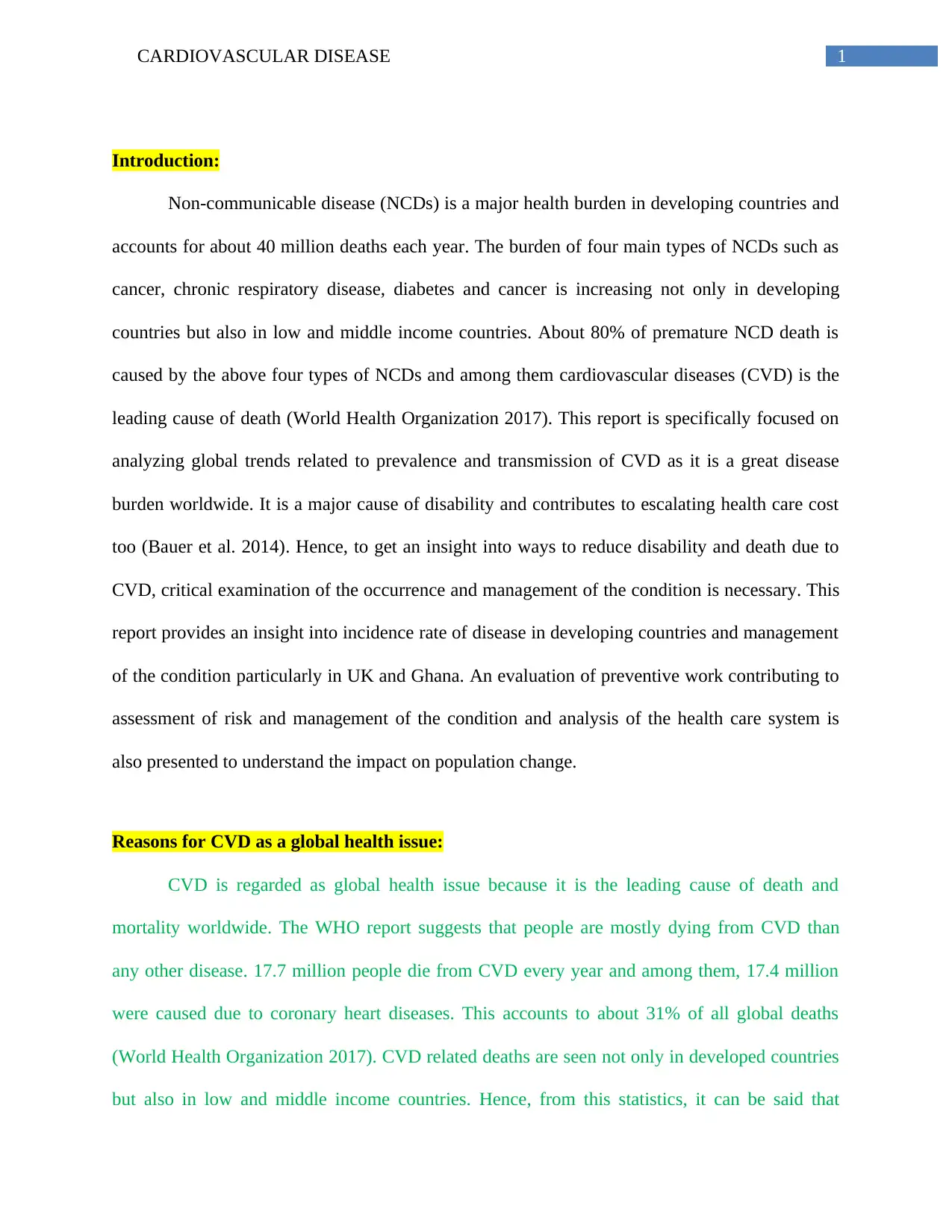
1CARDIOVASCULAR DISEASE
Introduction:
Non-communicable disease (NCDs) is a major health burden in developing countries and
accounts for about 40 million deaths each year. The burden of four main types of NCDs such as
cancer, chronic respiratory disease, diabetes and cancer is increasing not only in developing
countries but also in low and middle income countries. About 80% of premature NCD death is
caused by the above four types of NCDs and among them cardiovascular diseases (CVD) is the
leading cause of death (World Health Organization 2017). This report is specifically focused on
analyzing global trends related to prevalence and transmission of CVD as it is a great disease
burden worldwide. It is a major cause of disability and contributes to escalating health care cost
too (Bauer et al. 2014). Hence, to get an insight into ways to reduce disability and death due to
CVD, critical examination of the occurrence and management of the condition is necessary. This
report provides an insight into incidence rate of disease in developing countries and management
of the condition particularly in UK and Ghana. An evaluation of preventive work contributing to
assessment of risk and management of the condition and analysis of the health care system is
also presented to understand the impact on population change.
Reasons for CVD as a global health issue:
CVD is regarded as global health issue because it is the leading cause of death and
mortality worldwide. The WHO report suggests that people are mostly dying from CVD than
any other disease. 17.7 million people die from CVD every year and among them, 17.4 million
were caused due to coronary heart diseases. This accounts to about 31% of all global deaths
(World Health Organization 2017). CVD related deaths are seen not only in developed countries
but also in low and middle income countries. Hence, from this statistics, it can be said that
Introduction:
Non-communicable disease (NCDs) is a major health burden in developing countries and
accounts for about 40 million deaths each year. The burden of four main types of NCDs such as
cancer, chronic respiratory disease, diabetes and cancer is increasing not only in developing
countries but also in low and middle income countries. About 80% of premature NCD death is
caused by the above four types of NCDs and among them cardiovascular diseases (CVD) is the
leading cause of death (World Health Organization 2017). This report is specifically focused on
analyzing global trends related to prevalence and transmission of CVD as it is a great disease
burden worldwide. It is a major cause of disability and contributes to escalating health care cost
too (Bauer et al. 2014). Hence, to get an insight into ways to reduce disability and death due to
CVD, critical examination of the occurrence and management of the condition is necessary. This
report provides an insight into incidence rate of disease in developing countries and management
of the condition particularly in UK and Ghana. An evaluation of preventive work contributing to
assessment of risk and management of the condition and analysis of the health care system is
also presented to understand the impact on population change.
Reasons for CVD as a global health issue:
CVD is regarded as global health issue because it is the leading cause of death and
mortality worldwide. The WHO report suggests that people are mostly dying from CVD than
any other disease. 17.7 million people die from CVD every year and among them, 17.4 million
were caused due to coronary heart diseases. This accounts to about 31% of all global deaths
(World Health Organization 2017). CVD related deaths are seen not only in developed countries
but also in low and middle income countries. Hence, from this statistics, it can be said that

2CARDIOVASCULAR DISEASE
burden of health care system is the largest due to the epidemic of CVD. It has been the reason for
increase in health care cost, increased duration of hospital stay and loss of productivity of
countries. It indicates the need for better preventive work and assessment of risk to control the
prevalence of the disease condition (Joseph et al. 2017).
Attributes of the health issue:
CVD is a class of heart disease consisting of coronoray artery disease, stroke,
cardiomaypathy and many other disorders causes mainly by selected risk factors. Malambo et al.
2016). The characteristics and attributes of illness mainly involves disruption in the function of
heart.. The pathophysiology of CVD involves four characteristics: heart dysfunction, vasculad
dysfunction, For instance, in case of coronary heart disease, plaque buildup in the epithelial
lining of arteries results in disruption in the supply of oxygen and nutrients to the blood.
Lifestyle factors and work characteristics also acts as a major factor contributing to the risk of
CVD. Several biological and social factors increase the risk of the disease (Thomas and Power
2009). All these factors create the pathyway for development of heart disorders.
Epidemiological trend, transition and environmental causes
Incidence rate and prevalence of the condition in developed and developing countries:
High incidence of CVD in developed and developing country is a challenge for the health
care system because of increase in hospital admission and great burden in the management of the
condition (Lackland and Weber 2015). For example in high come country like USA, about 92.1
million adults have at least 1 type of CVD, however the death rate has declined by 25.3% from
2004 to 2014 (Benjamin et al. 2017). According to 2017 heart disease statistics, one in every
burden of health care system is the largest due to the epidemic of CVD. It has been the reason for
increase in health care cost, increased duration of hospital stay and loss of productivity of
countries. It indicates the need for better preventive work and assessment of risk to control the
prevalence of the disease condition (Joseph et al. 2017).
Attributes of the health issue:
CVD is a class of heart disease consisting of coronoray artery disease, stroke,
cardiomaypathy and many other disorders causes mainly by selected risk factors. Malambo et al.
2016). The characteristics and attributes of illness mainly involves disruption in the function of
heart.. The pathophysiology of CVD involves four characteristics: heart dysfunction, vasculad
dysfunction, For instance, in case of coronary heart disease, plaque buildup in the epithelial
lining of arteries results in disruption in the supply of oxygen and nutrients to the blood.
Lifestyle factors and work characteristics also acts as a major factor contributing to the risk of
CVD. Several biological and social factors increase the risk of the disease (Thomas and Power
2009). All these factors create the pathyway for development of heart disorders.
Epidemiological trend, transition and environmental causes
Incidence rate and prevalence of the condition in developed and developing countries:
High incidence of CVD in developed and developing country is a challenge for the health
care system because of increase in hospital admission and great burden in the management of the
condition (Lackland and Weber 2015). For example in high come country like USA, about 92.1
million adults have at least 1 type of CVD, however the death rate has declined by 25.3% from
2004 to 2014 (Benjamin et al. 2017). According to 2017 heart disease statistics, one in every
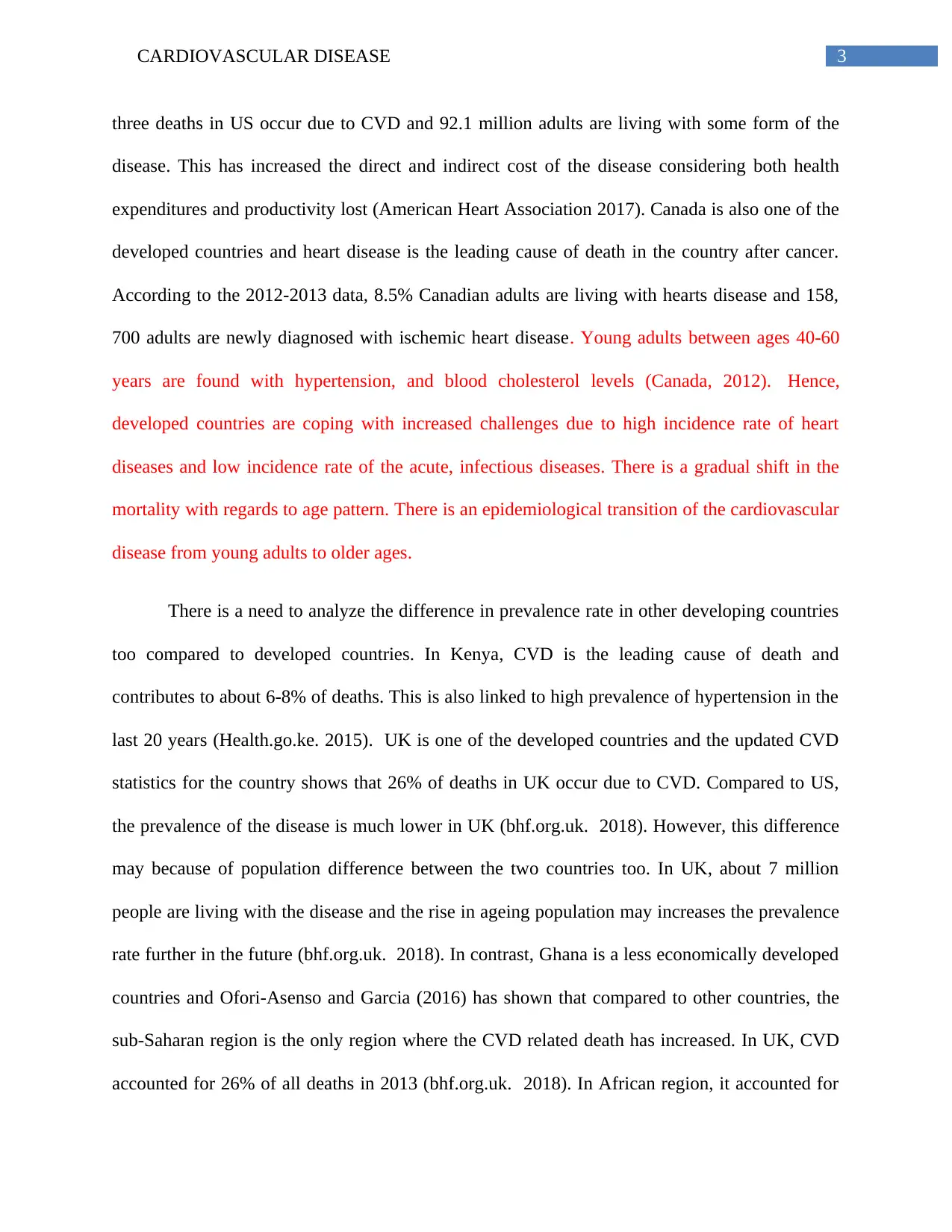
3CARDIOVASCULAR DISEASE
three deaths in US occur due to CVD and 92.1 million adults are living with some form of the
disease. This has increased the direct and indirect cost of the disease considering both health
expenditures and productivity lost (American Heart Association 2017). Canada is also one of the
developed countries and heart disease is the leading cause of death in the country after cancer.
According to the 2012-2013 data, 8.5% Canadian adults are living with hearts disease and 158,
700 adults are newly diagnosed with ischemic heart disease. Young adults between ages 40-60
years are found with hypertension, and blood cholesterol levels (Canada, 2012). Hence,
developed countries are coping with increased challenges due to high incidence rate of heart
diseases and low incidence rate of the acute, infectious diseases. There is a gradual shift in the
mortality with regards to age pattern. There is an epidemiological transition of the cardiovascular
disease from young adults to older ages.
There is a need to analyze the difference in prevalence rate in other developing countries
too compared to developed countries. In Kenya, CVD is the leading cause of death and
contributes to about 6-8% of deaths. This is also linked to high prevalence of hypertension in the
last 20 years (Health.go.ke. 2015). UK is one of the developed countries and the updated CVD
statistics for the country shows that 26% of deaths in UK occur due to CVD. Compared to US,
the prevalence of the disease is much lower in UK (bhf.org.uk. 2018). However, this difference
may because of population difference between the two countries too. In UK, about 7 million
people are living with the disease and the rise in ageing population may increases the prevalence
rate further in the future (bhf.org.uk. 2018). In contrast, Ghana is a less economically developed
countries and Ofori-Asenso and Garcia (2016) has shown that compared to other countries, the
sub-Saharan region is the only region where the CVD related death has increased. In UK, CVD
accounted for 26% of all deaths in 2013 (bhf.org.uk. 2018). In African region, it accounted for
three deaths in US occur due to CVD and 92.1 million adults are living with some form of the
disease. This has increased the direct and indirect cost of the disease considering both health
expenditures and productivity lost (American Heart Association 2017). Canada is also one of the
developed countries and heart disease is the leading cause of death in the country after cancer.
According to the 2012-2013 data, 8.5% Canadian adults are living with hearts disease and 158,
700 adults are newly diagnosed with ischemic heart disease. Young adults between ages 40-60
years are found with hypertension, and blood cholesterol levels (Canada, 2012). Hence,
developed countries are coping with increased challenges due to high incidence rate of heart
diseases and low incidence rate of the acute, infectious diseases. There is a gradual shift in the
mortality with regards to age pattern. There is an epidemiological transition of the cardiovascular
disease from young adults to older ages.
There is a need to analyze the difference in prevalence rate in other developing countries
too compared to developed countries. In Kenya, CVD is the leading cause of death and
contributes to about 6-8% of deaths. This is also linked to high prevalence of hypertension in the
last 20 years (Health.go.ke. 2015). UK is one of the developed countries and the updated CVD
statistics for the country shows that 26% of deaths in UK occur due to CVD. Compared to US,
the prevalence of the disease is much lower in UK (bhf.org.uk. 2018). However, this difference
may because of population difference between the two countries too. In UK, about 7 million
people are living with the disease and the rise in ageing population may increases the prevalence
rate further in the future (bhf.org.uk. 2018). In contrast, Ghana is a less economically developed
countries and Ofori-Asenso and Garcia (2016) has shown that compared to other countries, the
sub-Saharan region is the only region where the CVD related death has increased. In UK, CVD
accounted for 26% of all deaths in 2013 (bhf.org.uk. 2018). In African region, it accounted for
Secure Best Marks with AI Grader
Need help grading? Try our AI Grader for instant feedback on your assignments.
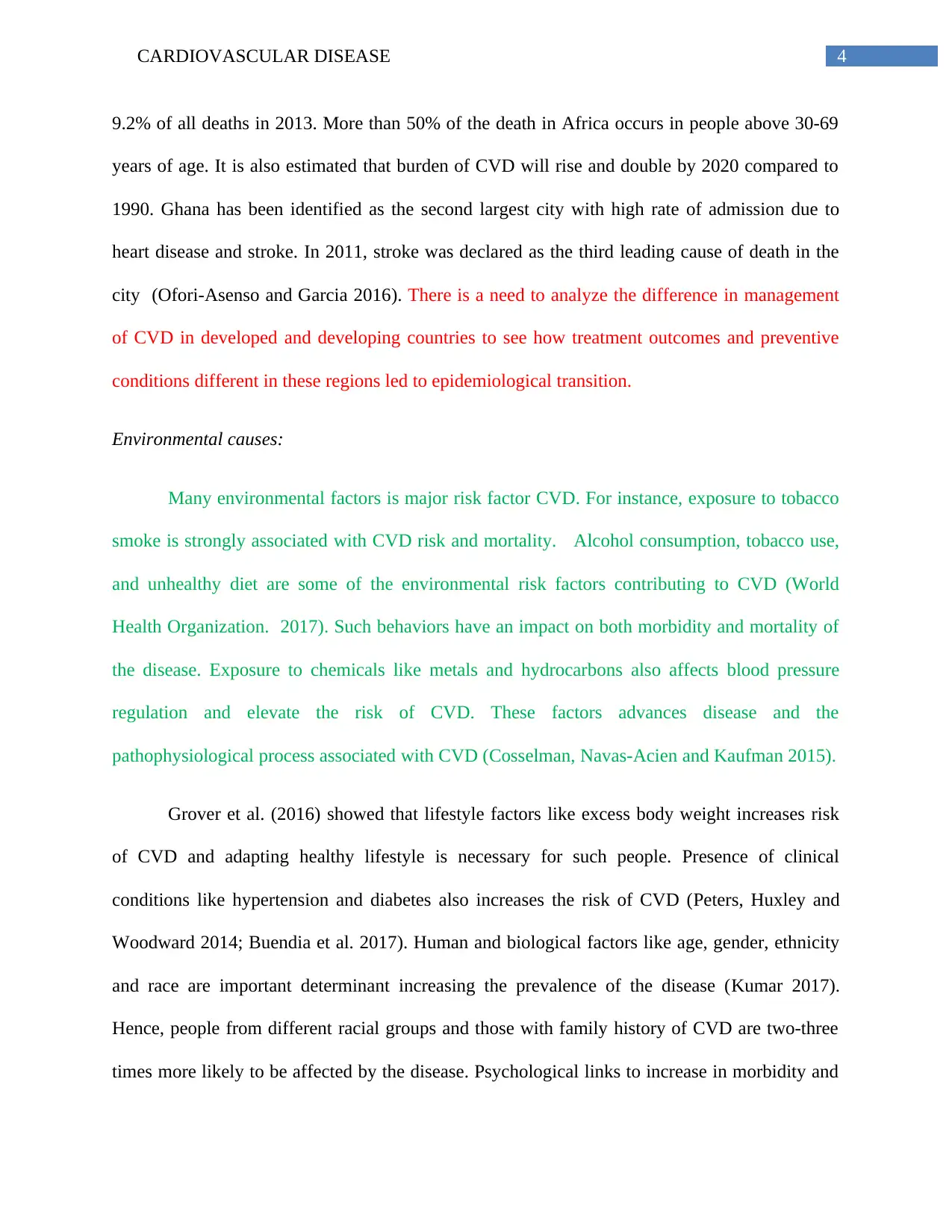
4CARDIOVASCULAR DISEASE
9.2% of all deaths in 2013. More than 50% of the death in Africa occurs in people above 30-69
years of age. It is also estimated that burden of CVD will rise and double by 2020 compared to
1990. Ghana has been identified as the second largest city with high rate of admission due to
heart disease and stroke. In 2011, stroke was declared as the third leading cause of death in the
city (Ofori-Asenso and Garcia 2016). There is a need to analyze the difference in management
of CVD in developed and developing countries to see how treatment outcomes and preventive
conditions different in these regions led to epidemiological transition.
Environmental causes:
Many environmental factors is major risk factor CVD. For instance, exposure to tobacco
smoke is strongly associated with CVD risk and mortality. Alcohol consumption, tobacco use,
and unhealthy diet are some of the environmental risk factors contributing to CVD (World
Health Organization. 2017). Such behaviors have an impact on both morbidity and mortality of
the disease. Exposure to chemicals like metals and hydrocarbons also affects blood pressure
regulation and elevate the risk of CVD. These factors advances disease and the
pathophysiological process associated with CVD (Cosselman, Navas-Acien and Kaufman 2015).
Grover et al. (2016) showed that lifestyle factors like excess body weight increases risk
of CVD and adapting healthy lifestyle is necessary for such people. Presence of clinical
conditions like hypertension and diabetes also increases the risk of CVD (Peters, Huxley and
Woodward 2014; Buendia et al. 2017). Human and biological factors like age, gender, ethnicity
and race are important determinant increasing the prevalence of the disease (Kumar 2017).
Hence, people from different racial groups and those with family history of CVD are two-three
times more likely to be affected by the disease. Psychological links to increase in morbidity and
9.2% of all deaths in 2013. More than 50% of the death in Africa occurs in people above 30-69
years of age. It is also estimated that burden of CVD will rise and double by 2020 compared to
1990. Ghana has been identified as the second largest city with high rate of admission due to
heart disease and stroke. In 2011, stroke was declared as the third leading cause of death in the
city (Ofori-Asenso and Garcia 2016). There is a need to analyze the difference in management
of CVD in developed and developing countries to see how treatment outcomes and preventive
conditions different in these regions led to epidemiological transition.
Environmental causes:
Many environmental factors is major risk factor CVD. For instance, exposure to tobacco
smoke is strongly associated with CVD risk and mortality. Alcohol consumption, tobacco use,
and unhealthy diet are some of the environmental risk factors contributing to CVD (World
Health Organization. 2017). Such behaviors have an impact on both morbidity and mortality of
the disease. Exposure to chemicals like metals and hydrocarbons also affects blood pressure
regulation and elevate the risk of CVD. These factors advances disease and the
pathophysiological process associated with CVD (Cosselman, Navas-Acien and Kaufman 2015).
Grover et al. (2016) showed that lifestyle factors like excess body weight increases risk
of CVD and adapting healthy lifestyle is necessary for such people. Presence of clinical
conditions like hypertension and diabetes also increases the risk of CVD (Peters, Huxley and
Woodward 2014; Buendia et al. 2017). Human and biological factors like age, gender, ethnicity
and race are important determinant increasing the prevalence of the disease (Kumar 2017).
Hence, people from different racial groups and those with family history of CVD are two-three
times more likely to be affected by the disease. Psychological links to increase in morbidity and

5CARDIOVASCULAR DISEASE
mortality risk among CVD patients has also been established as Gallo et al. (2014) showed
impact of perceived stress and anxiety on risk of developing CVD. The review of these risk
factors suggest that CVD can be prevented by focusing on health education and lifestyle changes
and effective implementation of preventable health programs.
In conclusion preventive strategies and not advancement in clinical medicine over years
have been found to increase the life expectancy leading to demographic transitions. The
transition can be attributed to various extents of the socio-economic development, medical
interventions and public health as observed from the late 20th century. In developing countries
the epidemics of the non-communicable diseases are the major contributors of the disease burden
as infections are decreasing as leading contributors. Genetic predisposition and environmental
causes are the factors contributing to the dynamics of CVD epidemic.
Prevention (Primary, secondary and tertiary):
Management of the condition in UK and Ghana with reference to primary, secondary and
tertiary prevention:
UK:
The global health trends and prevalence of CVD in developed and developing countries
were provided in the above sections. This section particularly looks at the way the condition is
managed in UKA and Ghana with reference to primary, secondary and tertiary prevention
programmes. The primary prevention programs are those which focus on preventing the disease
before it occurs or before it is diagnosed in a population group (Goldstein et al. 2010). Some of
mortality risk among CVD patients has also been established as Gallo et al. (2014) showed
impact of perceived stress and anxiety on risk of developing CVD. The review of these risk
factors suggest that CVD can be prevented by focusing on health education and lifestyle changes
and effective implementation of preventable health programs.
In conclusion preventive strategies and not advancement in clinical medicine over years
have been found to increase the life expectancy leading to demographic transitions. The
transition can be attributed to various extents of the socio-economic development, medical
interventions and public health as observed from the late 20th century. In developing countries
the epidemics of the non-communicable diseases are the major contributors of the disease burden
as infections are decreasing as leading contributors. Genetic predisposition and environmental
causes are the factors contributing to the dynamics of CVD epidemic.
Prevention (Primary, secondary and tertiary):
Management of the condition in UK and Ghana with reference to primary, secondary and
tertiary prevention:
UK:
The global health trends and prevalence of CVD in developed and developing countries
were provided in the above sections. This section particularly looks at the way the condition is
managed in UKA and Ghana with reference to primary, secondary and tertiary prevention
programmes. The primary prevention programs are those which focus on preventing the disease
before it occurs or before it is diagnosed in a population group (Goldstein et al. 2010). Some of

6CARDIOVASCULAR DISEASE
the main components of primary prevention program include health education, environmental
modification and lifestyle and behavioral modification to minimize the risk of developing heart
diseases (Drummond et al. 2015). In UK, one of the major preventive health strategies for
management of CVD was to reduce the prevalence of smoking. At the national level, the UK
Government implemented several programmes to prevent CVD. These included setting national
priorities for reducing premature mortality, controlling obesity and tobacco use, decreasing
alcohol consumptions and encouraging physical activity in citizens. Many social marketing
campaigns like Change4Life were implemented so that people could adapt healthy lifestyles
(Department of Health 2013).
From the analysis of primary prevention programmes implemented in UK, it can be said
that a lot of emphasis was paid on controlling obesity and tobacco consumptions in people. This
can be regarded as an effective targeted intervention because high BMI and obesity is the reason
for development of CVD risk factors like hypertension and diabetes and these conditions
consequently increases the risk of CVD (Bastien et al. 2014). Change4Life was the first national
social marketing campaign to reduce obesity in England and a three year marketing strategy was
implemented to support people at each stage of behavioral change. This campaign was a great
success at it covered 99% targeted families in the first year and great response were received
from citizens after year of the campaign. It was great social marketing campaign that provided
handbooks and web-content to help people change their behavior and collaborated with non-
governmental sector to boost behavioral changes in obese people (Dibb 2017). This campaign
along with Responsibility Deal framework was also responsible for implementing policies to
support industries to produce healthier produces and minimize salt intake (Gillespie et al. 2015).
This campaign greatly increased awareness about the health risk associated with obesity,
the main components of primary prevention program include health education, environmental
modification and lifestyle and behavioral modification to minimize the risk of developing heart
diseases (Drummond et al. 2015). In UK, one of the major preventive health strategies for
management of CVD was to reduce the prevalence of smoking. At the national level, the UK
Government implemented several programmes to prevent CVD. These included setting national
priorities for reducing premature mortality, controlling obesity and tobacco use, decreasing
alcohol consumptions and encouraging physical activity in citizens. Many social marketing
campaigns like Change4Life were implemented so that people could adapt healthy lifestyles
(Department of Health 2013).
From the analysis of primary prevention programmes implemented in UK, it can be said
that a lot of emphasis was paid on controlling obesity and tobacco consumptions in people. This
can be regarded as an effective targeted intervention because high BMI and obesity is the reason
for development of CVD risk factors like hypertension and diabetes and these conditions
consequently increases the risk of CVD (Bastien et al. 2014). Change4Life was the first national
social marketing campaign to reduce obesity in England and a three year marketing strategy was
implemented to support people at each stage of behavioral change. This campaign was a great
success at it covered 99% targeted families in the first year and great response were received
from citizens after year of the campaign. It was great social marketing campaign that provided
handbooks and web-content to help people change their behavior and collaborated with non-
governmental sector to boost behavioral changes in obese people (Dibb 2017). This campaign
along with Responsibility Deal framework was also responsible for implementing policies to
support industries to produce healthier produces and minimize salt intake (Gillespie et al. 2015).
This campaign greatly increased awareness about the health risk associated with obesity,
Paraphrase This Document
Need a fresh take? Get an instant paraphrase of this document with our AI Paraphraser
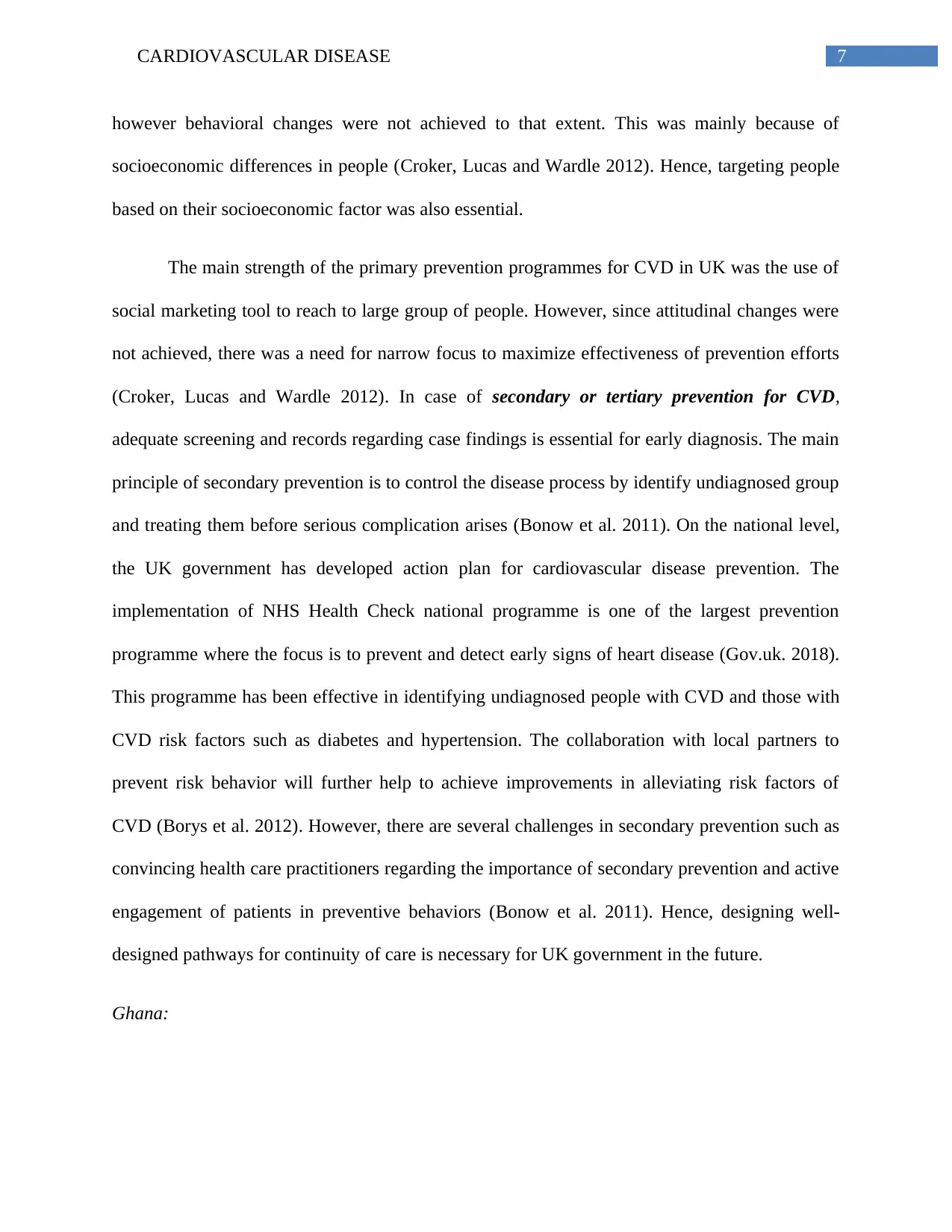
7CARDIOVASCULAR DISEASE
however behavioral changes were not achieved to that extent. This was mainly because of
socioeconomic differences in people (Croker, Lucas and Wardle 2012). Hence, targeting people
based on their socioeconomic factor was also essential.
The main strength of the primary prevention programmes for CVD in UK was the use of
social marketing tool to reach to large group of people. However, since attitudinal changes were
not achieved, there was a need for narrow focus to maximize effectiveness of prevention efforts
(Croker, Lucas and Wardle 2012). In case of secondary or tertiary prevention for CVD,
adequate screening and records regarding case findings is essential for early diagnosis. The main
principle of secondary prevention is to control the disease process by identify undiagnosed group
and treating them before serious complication arises (Bonow et al. 2011). On the national level,
the UK government has developed action plan for cardiovascular disease prevention. The
implementation of NHS Health Check national programme is one of the largest prevention
programme where the focus is to prevent and detect early signs of heart disease (Gov.uk. 2018).
This programme has been effective in identifying undiagnosed people with CVD and those with
CVD risk factors such as diabetes and hypertension. The collaboration with local partners to
prevent risk behavior will further help to achieve improvements in alleviating risk factors of
CVD (Borys et al. 2012). However, there are several challenges in secondary prevention such as
convincing health care practitioners regarding the importance of secondary prevention and active
engagement of patients in preventive behaviors (Bonow et al. 2011). Hence, designing well-
designed pathways for continuity of care is necessary for UK government in the future.
Ghana:
however behavioral changes were not achieved to that extent. This was mainly because of
socioeconomic differences in people (Croker, Lucas and Wardle 2012). Hence, targeting people
based on their socioeconomic factor was also essential.
The main strength of the primary prevention programmes for CVD in UK was the use of
social marketing tool to reach to large group of people. However, since attitudinal changes were
not achieved, there was a need for narrow focus to maximize effectiveness of prevention efforts
(Croker, Lucas and Wardle 2012). In case of secondary or tertiary prevention for CVD,
adequate screening and records regarding case findings is essential for early diagnosis. The main
principle of secondary prevention is to control the disease process by identify undiagnosed group
and treating them before serious complication arises (Bonow et al. 2011). On the national level,
the UK government has developed action plan for cardiovascular disease prevention. The
implementation of NHS Health Check national programme is one of the largest prevention
programme where the focus is to prevent and detect early signs of heart disease (Gov.uk. 2018).
This programme has been effective in identifying undiagnosed people with CVD and those with
CVD risk factors such as diabetes and hypertension. The collaboration with local partners to
prevent risk behavior will further help to achieve improvements in alleviating risk factors of
CVD (Borys et al. 2012). However, there are several challenges in secondary prevention such as
convincing health care practitioners regarding the importance of secondary prevention and active
engagement of patients in preventive behaviors (Bonow et al. 2011). Hence, designing well-
designed pathways for continuity of care is necessary for UK government in the future.
Ghana:
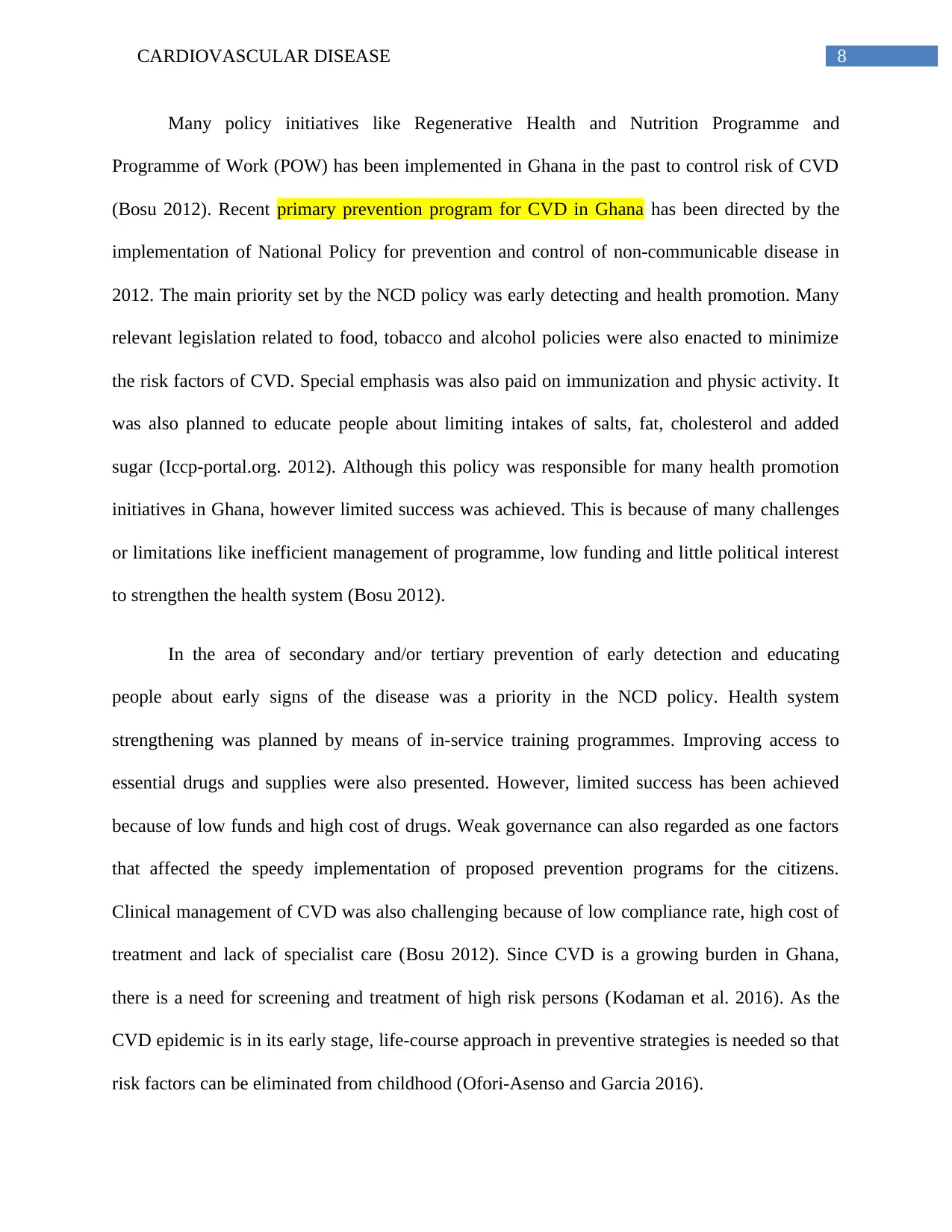
8CARDIOVASCULAR DISEASE
Many policy initiatives like Regenerative Health and Nutrition Programme and
Programme of Work (POW) has been implemented in Ghana in the past to control risk of CVD
(Bosu 2012). Recent primary prevention program for CVD in Ghana has been directed by the
implementation of National Policy for prevention and control of non-communicable disease in
2012. The main priority set by the NCD policy was early detecting and health promotion. Many
relevant legislation related to food, tobacco and alcohol policies were also enacted to minimize
the risk factors of CVD. Special emphasis was also paid on immunization and physic activity. It
was also planned to educate people about limiting intakes of salts, fat, cholesterol and added
sugar (Iccp-portal.org. 2012). Although this policy was responsible for many health promotion
initiatives in Ghana, however limited success was achieved. This is because of many challenges
or limitations like inefficient management of programme, low funding and little political interest
to strengthen the health system (Bosu 2012).
In the area of secondary and/or tertiary prevention of early detection and educating
people about early signs of the disease was a priority in the NCD policy. Health system
strengthening was planned by means of in-service training programmes. Improving access to
essential drugs and supplies were also presented. However, limited success has been achieved
because of low funds and high cost of drugs. Weak governance can also regarded as one factors
that affected the speedy implementation of proposed prevention programs for the citizens.
Clinical management of CVD was also challenging because of low compliance rate, high cost of
treatment and lack of specialist care (Bosu 2012). Since CVD is a growing burden in Ghana,
there is a need for screening and treatment of high risk persons (Kodaman et al. 2016). As the
CVD epidemic is in its early stage, life-course approach in preventive strategies is needed so that
risk factors can be eliminated from childhood (Ofori-Asenso and Garcia 2016).
Many policy initiatives like Regenerative Health and Nutrition Programme and
Programme of Work (POW) has been implemented in Ghana in the past to control risk of CVD
(Bosu 2012). Recent primary prevention program for CVD in Ghana has been directed by the
implementation of National Policy for prevention and control of non-communicable disease in
2012. The main priority set by the NCD policy was early detecting and health promotion. Many
relevant legislation related to food, tobacco and alcohol policies were also enacted to minimize
the risk factors of CVD. Special emphasis was also paid on immunization and physic activity. It
was also planned to educate people about limiting intakes of salts, fat, cholesterol and added
sugar (Iccp-portal.org. 2012). Although this policy was responsible for many health promotion
initiatives in Ghana, however limited success was achieved. This is because of many challenges
or limitations like inefficient management of programme, low funding and little political interest
to strengthen the health system (Bosu 2012).
In the area of secondary and/or tertiary prevention of early detection and educating
people about early signs of the disease was a priority in the NCD policy. Health system
strengthening was planned by means of in-service training programmes. Improving access to
essential drugs and supplies were also presented. However, limited success has been achieved
because of low funds and high cost of drugs. Weak governance can also regarded as one factors
that affected the speedy implementation of proposed prevention programs for the citizens.
Clinical management of CVD was also challenging because of low compliance rate, high cost of
treatment and lack of specialist care (Bosu 2012). Since CVD is a growing burden in Ghana,
there is a need for screening and treatment of high risk persons (Kodaman et al. 2016). As the
CVD epidemic is in its early stage, life-course approach in preventive strategies is needed so that
risk factors can be eliminated from childhood (Ofori-Asenso and Garcia 2016).
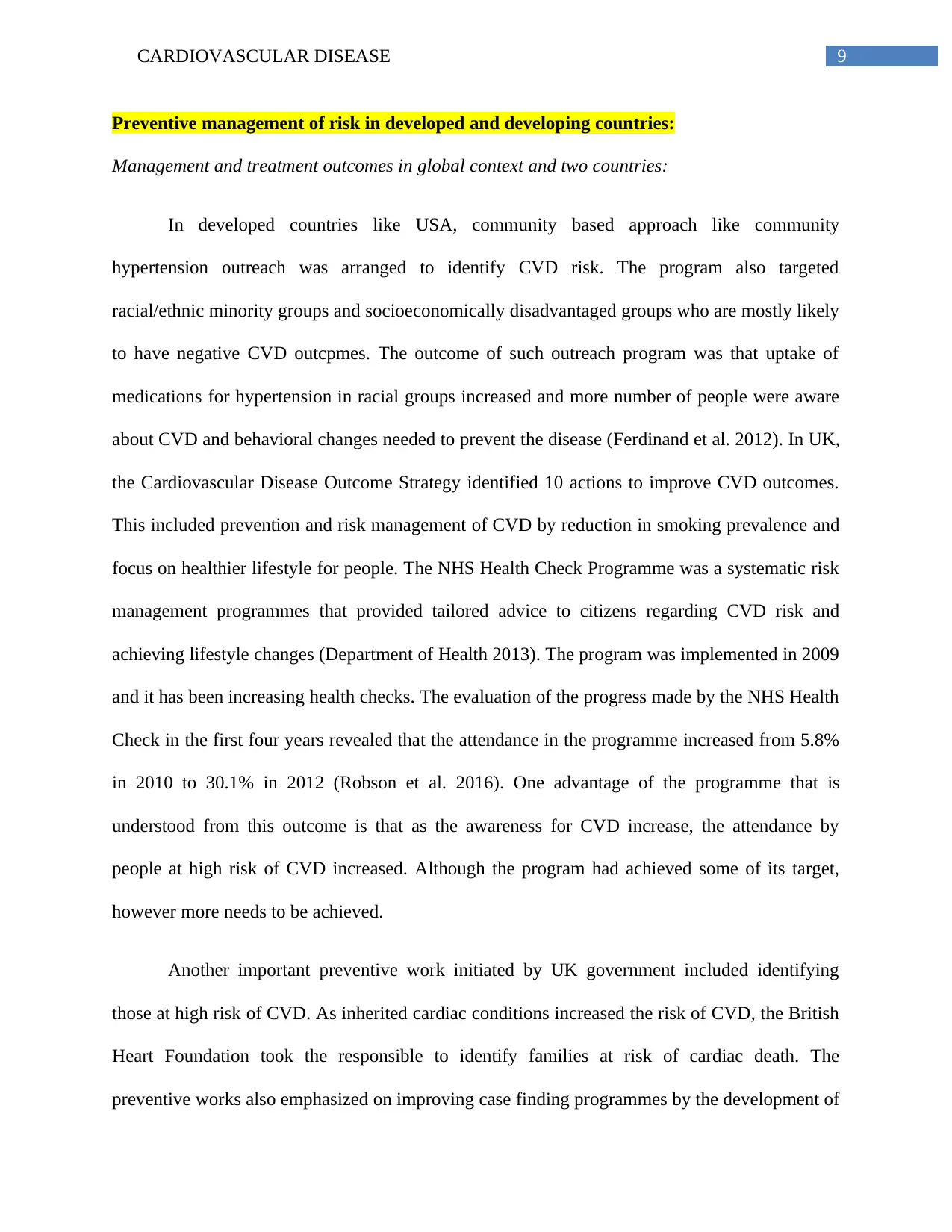
9CARDIOVASCULAR DISEASE
Preventive management of risk in developed and developing countries:
Management and treatment outcomes in global context and two countries:
In developed countries like USA, community based approach like community
hypertension outreach was arranged to identify CVD risk. The program also targeted
racial/ethnic minority groups and socioeconomically disadvantaged groups who are mostly likely
to have negative CVD outcpmes. The outcome of such outreach program was that uptake of
medications for hypertension in racial groups increased and more number of people were aware
about CVD and behavioral changes needed to prevent the disease (Ferdinand et al. 2012). In UK,
the Cardiovascular Disease Outcome Strategy identified 10 actions to improve CVD outcomes.
This included prevention and risk management of CVD by reduction in smoking prevalence and
focus on healthier lifestyle for people. The NHS Health Check Programme was a systematic risk
management programmes that provided tailored advice to citizens regarding CVD risk and
achieving lifestyle changes (Department of Health 2013). The program was implemented in 2009
and it has been increasing health checks. The evaluation of the progress made by the NHS Health
Check in the first four years revealed that the attendance in the programme increased from 5.8%
in 2010 to 30.1% in 2012 (Robson et al. 2016). One advantage of the programme that is
understood from this outcome is that as the awareness for CVD increase, the attendance by
people at high risk of CVD increased. Although the program had achieved some of its target,
however more needs to be achieved.
Another important preventive work initiated by UK government included identifying
those at high risk of CVD. As inherited cardiac conditions increased the risk of CVD, the British
Heart Foundation took the responsible to identify families at risk of cardiac death. The
preventive works also emphasized on improving case finding programmes by the development of
Preventive management of risk in developed and developing countries:
Management and treatment outcomes in global context and two countries:
In developed countries like USA, community based approach like community
hypertension outreach was arranged to identify CVD risk. The program also targeted
racial/ethnic minority groups and socioeconomically disadvantaged groups who are mostly likely
to have negative CVD outcpmes. The outcome of such outreach program was that uptake of
medications for hypertension in racial groups increased and more number of people were aware
about CVD and behavioral changes needed to prevent the disease (Ferdinand et al. 2012). In UK,
the Cardiovascular Disease Outcome Strategy identified 10 actions to improve CVD outcomes.
This included prevention and risk management of CVD by reduction in smoking prevalence and
focus on healthier lifestyle for people. The NHS Health Check Programme was a systematic risk
management programmes that provided tailored advice to citizens regarding CVD risk and
achieving lifestyle changes (Department of Health 2013). The program was implemented in 2009
and it has been increasing health checks. The evaluation of the progress made by the NHS Health
Check in the first four years revealed that the attendance in the programme increased from 5.8%
in 2010 to 30.1% in 2012 (Robson et al. 2016). One advantage of the programme that is
understood from this outcome is that as the awareness for CVD increase, the attendance by
people at high risk of CVD increased. Although the program had achieved some of its target,
however more needs to be achieved.
Another important preventive work initiated by UK government included identifying
those at high risk of CVD. As inherited cardiac conditions increased the risk of CVD, the British
Heart Foundation took the responsible to identify families at risk of cardiac death. The
preventive works also emphasized on improving case finding programmes by the development of
Secure Best Marks with AI Grader
Need help grading? Try our AI Grader for instant feedback on your assignments.
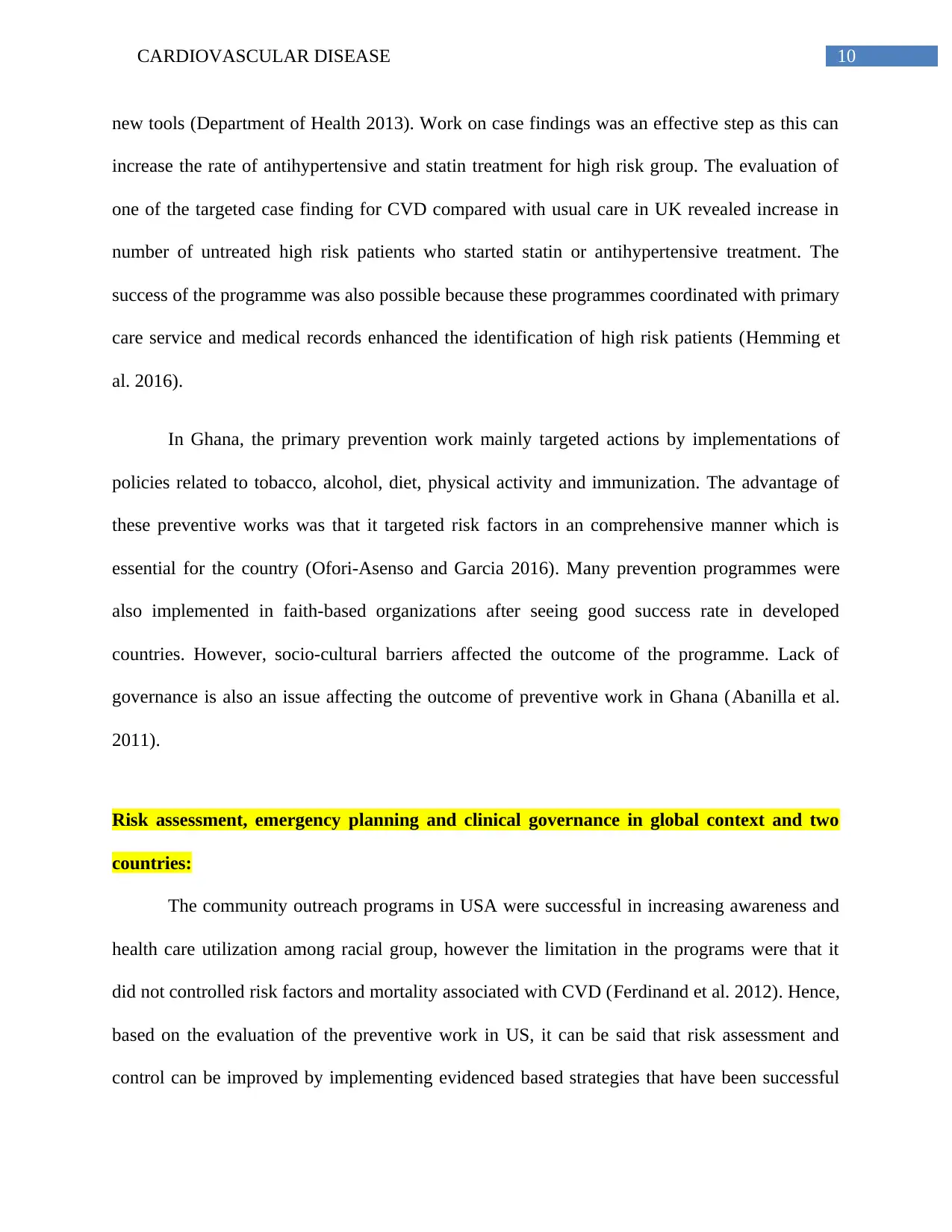
10CARDIOVASCULAR DISEASE
new tools (Department of Health 2013). Work on case findings was an effective step as this can
increase the rate of antihypertensive and statin treatment for high risk group. The evaluation of
one of the targeted case finding for CVD compared with usual care in UK revealed increase in
number of untreated high risk patients who started statin or antihypertensive treatment. The
success of the programme was also possible because these programmes coordinated with primary
care service and medical records enhanced the identification of high risk patients (Hemming et
al. 2016).
In Ghana, the primary prevention work mainly targeted actions by implementations of
policies related to tobacco, alcohol, diet, physical activity and immunization. The advantage of
these preventive works was that it targeted risk factors in an comprehensive manner which is
essential for the country (Ofori-Asenso and Garcia 2016). Many prevention programmes were
also implemented in faith-based organizations after seeing good success rate in developed
countries. However, socio-cultural barriers affected the outcome of the programme. Lack of
governance is also an issue affecting the outcome of preventive work in Ghana (Abanilla et al.
2011).
Risk assessment, emergency planning and clinical governance in global context and two
countries:
The community outreach programs in USA were successful in increasing awareness and
health care utilization among racial group, however the limitation in the programs were that it
did not controlled risk factors and mortality associated with CVD (Ferdinand et al. 2012). Hence,
based on the evaluation of the preventive work in US, it can be said that risk assessment and
control can be improved by implementing evidenced based strategies that have been successful
new tools (Department of Health 2013). Work on case findings was an effective step as this can
increase the rate of antihypertensive and statin treatment for high risk group. The evaluation of
one of the targeted case finding for CVD compared with usual care in UK revealed increase in
number of untreated high risk patients who started statin or antihypertensive treatment. The
success of the programme was also possible because these programmes coordinated with primary
care service and medical records enhanced the identification of high risk patients (Hemming et
al. 2016).
In Ghana, the primary prevention work mainly targeted actions by implementations of
policies related to tobacco, alcohol, diet, physical activity and immunization. The advantage of
these preventive works was that it targeted risk factors in an comprehensive manner which is
essential for the country (Ofori-Asenso and Garcia 2016). Many prevention programmes were
also implemented in faith-based organizations after seeing good success rate in developed
countries. However, socio-cultural barriers affected the outcome of the programme. Lack of
governance is also an issue affecting the outcome of preventive work in Ghana (Abanilla et al.
2011).
Risk assessment, emergency planning and clinical governance in global context and two
countries:
The community outreach programs in USA were successful in increasing awareness and
health care utilization among racial group, however the limitation in the programs were that it
did not controlled risk factors and mortality associated with CVD (Ferdinand et al. 2012). Hence,
based on the evaluation of the preventive work in US, it can be said that risk assessment and
control can be improved by implementing evidenced based strategies that have been successful

11CARDIOVASCULAR DISEASE
in the past (James et al. 2014). In case of UK, it has been found that well structured and
systematic risk assessment and risk management programmes are effective in raising awareness
and preventing CVD related outcomes. Year-by-year improvement in attendance was found and
the NHS Health Checks also led to the identification of new comorbidities (Robson et al. 2016).
However, other comprehensive strategy which might improve risk management of the disease
includes improving the infrastructure of the programme and regulation evaluation of progress to
ensure that desired target is achieved (Lee et al. 2016).
The success of case findings programmes in UK also contributes to the assessment of risk
and management of CVD. The evaluation of preventive works in UK in this area gives the lesson
that if dedicated staffs are involved and proper coordination with primary care is done, then
success of risk assessment process is guaranteed (Hemming et al. 2016). Tools like electronic
health records can be used to identify more number of patients with CVD risk (Pike et al. 2016).
In addition, the evaluation of preventive works in Ghana gives the insight that proper legal and
regulatory governance is critical for the success of prevention efforts. Governance reform is
essential to take effective response to the CVD epidemic (Piot et al. 2016). Hence, political
parties and several other parties must be involved to implement laws related to prevention of
LCD. Development agencies need to identify where maximum assistance is needed for the
success of preventive work and incident management for CVD. Educational policies are also
needed that starts health promotion in school curriculum too (Magnusson and Patterson 2014).
Evaluation of health promoting capacity of the health care systems:
All prevention efforts and regulatory changes related to CVD can be successful in a
country when the health care system of the country is prepared to tackle the epidemic. This
in the past (James et al. 2014). In case of UK, it has been found that well structured and
systematic risk assessment and risk management programmes are effective in raising awareness
and preventing CVD related outcomes. Year-by-year improvement in attendance was found and
the NHS Health Checks also led to the identification of new comorbidities (Robson et al. 2016).
However, other comprehensive strategy which might improve risk management of the disease
includes improving the infrastructure of the programme and regulation evaluation of progress to
ensure that desired target is achieved (Lee et al. 2016).
The success of case findings programmes in UK also contributes to the assessment of risk
and management of CVD. The evaluation of preventive works in UK in this area gives the lesson
that if dedicated staffs are involved and proper coordination with primary care is done, then
success of risk assessment process is guaranteed (Hemming et al. 2016). Tools like electronic
health records can be used to identify more number of patients with CVD risk (Pike et al. 2016).
In addition, the evaluation of preventive works in Ghana gives the insight that proper legal and
regulatory governance is critical for the success of prevention efforts. Governance reform is
essential to take effective response to the CVD epidemic (Piot et al. 2016). Hence, political
parties and several other parties must be involved to implement laws related to prevention of
LCD. Development agencies need to identify where maximum assistance is needed for the
success of preventive work and incident management for CVD. Educational policies are also
needed that starts health promotion in school curriculum too (Magnusson and Patterson 2014).
Evaluation of health promoting capacity of the health care systems:
All prevention efforts and regulatory changes related to CVD can be successful in a
country when the health care system of the country is prepared to tackle the epidemic. This
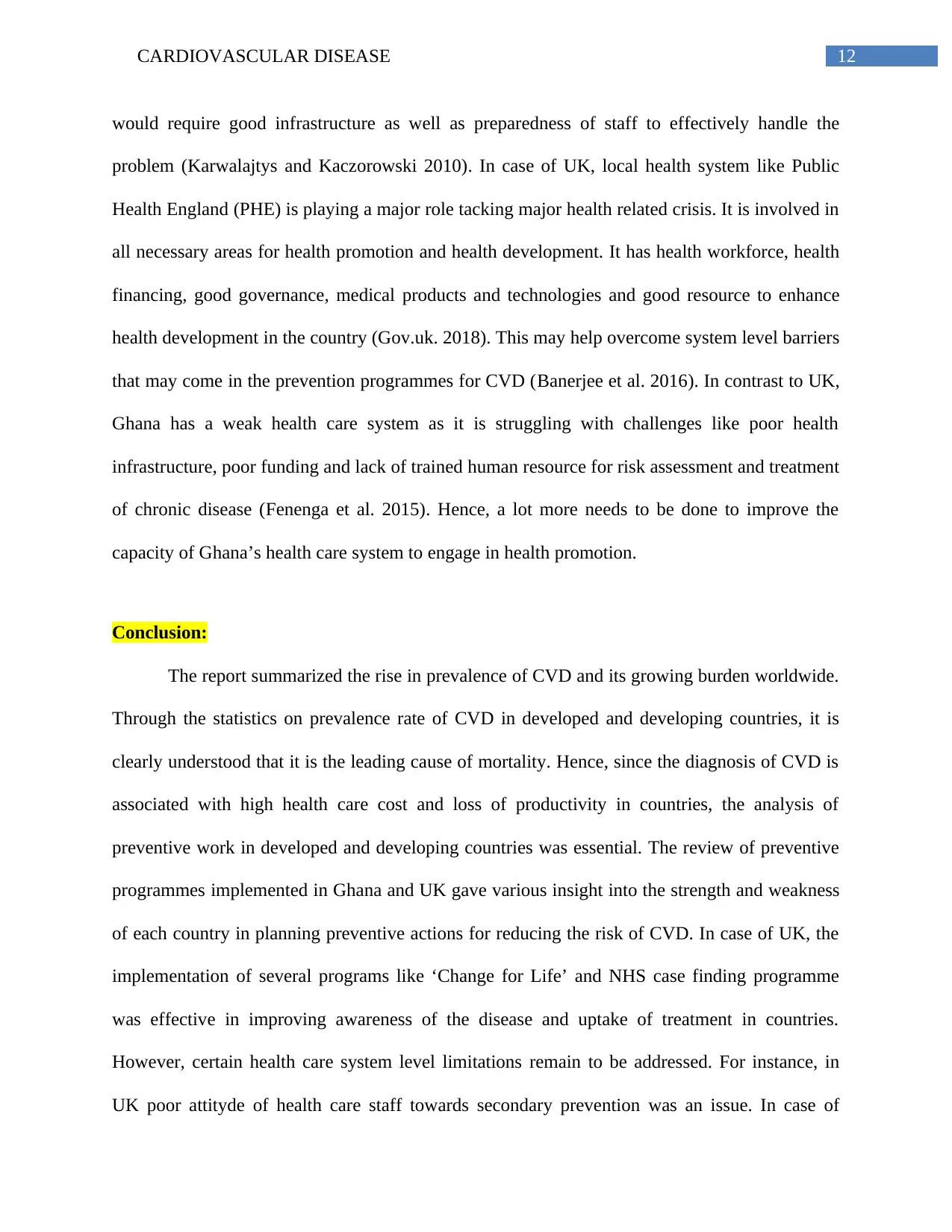
12CARDIOVASCULAR DISEASE
would require good infrastructure as well as preparedness of staff to effectively handle the
problem (Karwalajtys and Kaczorowski 2010). In case of UK, local health system like Public
Health England (PHE) is playing a major role tacking major health related crisis. It is involved in
all necessary areas for health promotion and health development. It has health workforce, health
financing, good governance, medical products and technologies and good resource to enhance
health development in the country (Gov.uk. 2018). This may help overcome system level barriers
that may come in the prevention programmes for CVD (Banerjee et al. 2016). In contrast to UK,
Ghana has a weak health care system as it is struggling with challenges like poor health
infrastructure, poor funding and lack of trained human resource for risk assessment and treatment
of chronic disease (Fenenga et al. 2015). Hence, a lot more needs to be done to improve the
capacity of Ghana’s health care system to engage in health promotion.
Conclusion:
The report summarized the rise in prevalence of CVD and its growing burden worldwide.
Through the statistics on prevalence rate of CVD in developed and developing countries, it is
clearly understood that it is the leading cause of mortality. Hence, since the diagnosis of CVD is
associated with high health care cost and loss of productivity in countries, the analysis of
preventive work in developed and developing countries was essential. The review of preventive
programmes implemented in Ghana and UK gave various insight into the strength and weakness
of each country in planning preventive actions for reducing the risk of CVD. In case of UK, the
implementation of several programs like ‘Change for Life’ and NHS case finding programme
was effective in improving awareness of the disease and uptake of treatment in countries.
However, certain health care system level limitations remain to be addressed. For instance, in
UK poor attityde of health care staff towards secondary prevention was an issue. In case of
would require good infrastructure as well as preparedness of staff to effectively handle the
problem (Karwalajtys and Kaczorowski 2010). In case of UK, local health system like Public
Health England (PHE) is playing a major role tacking major health related crisis. It is involved in
all necessary areas for health promotion and health development. It has health workforce, health
financing, good governance, medical products and technologies and good resource to enhance
health development in the country (Gov.uk. 2018). This may help overcome system level barriers
that may come in the prevention programmes for CVD (Banerjee et al. 2016). In contrast to UK,
Ghana has a weak health care system as it is struggling with challenges like poor health
infrastructure, poor funding and lack of trained human resource for risk assessment and treatment
of chronic disease (Fenenga et al. 2015). Hence, a lot more needs to be done to improve the
capacity of Ghana’s health care system to engage in health promotion.
Conclusion:
The report summarized the rise in prevalence of CVD and its growing burden worldwide.
Through the statistics on prevalence rate of CVD in developed and developing countries, it is
clearly understood that it is the leading cause of mortality. Hence, since the diagnosis of CVD is
associated with high health care cost and loss of productivity in countries, the analysis of
preventive work in developed and developing countries was essential. The review of preventive
programmes implemented in Ghana and UK gave various insight into the strength and weakness
of each country in planning preventive actions for reducing the risk of CVD. In case of UK, the
implementation of several programs like ‘Change for Life’ and NHS case finding programme
was effective in improving awareness of the disease and uptake of treatment in countries.
However, certain health care system level limitations remain to be addressed. For instance, in
UK poor attityde of health care staff towards secondary prevention was an issue. In case of
Paraphrase This Document
Need a fresh take? Get an instant paraphrase of this document with our AI Paraphraser

13CARDIOVASCULAR DISEASE
Ghana, poor governance and health care infrastructure affected the success of preventive work.
Hence, it is recommended these countries identifies the flaws in the health care system and
correct them to increase their capacity for health promotion and prevention of NCDs like CVD.
Ghana, poor governance and health care infrastructure affected the success of preventive work.
Hence, it is recommended these countries identifies the flaws in the health care system and
correct them to increase their capacity for health promotion and prevention of NCDs like CVD.
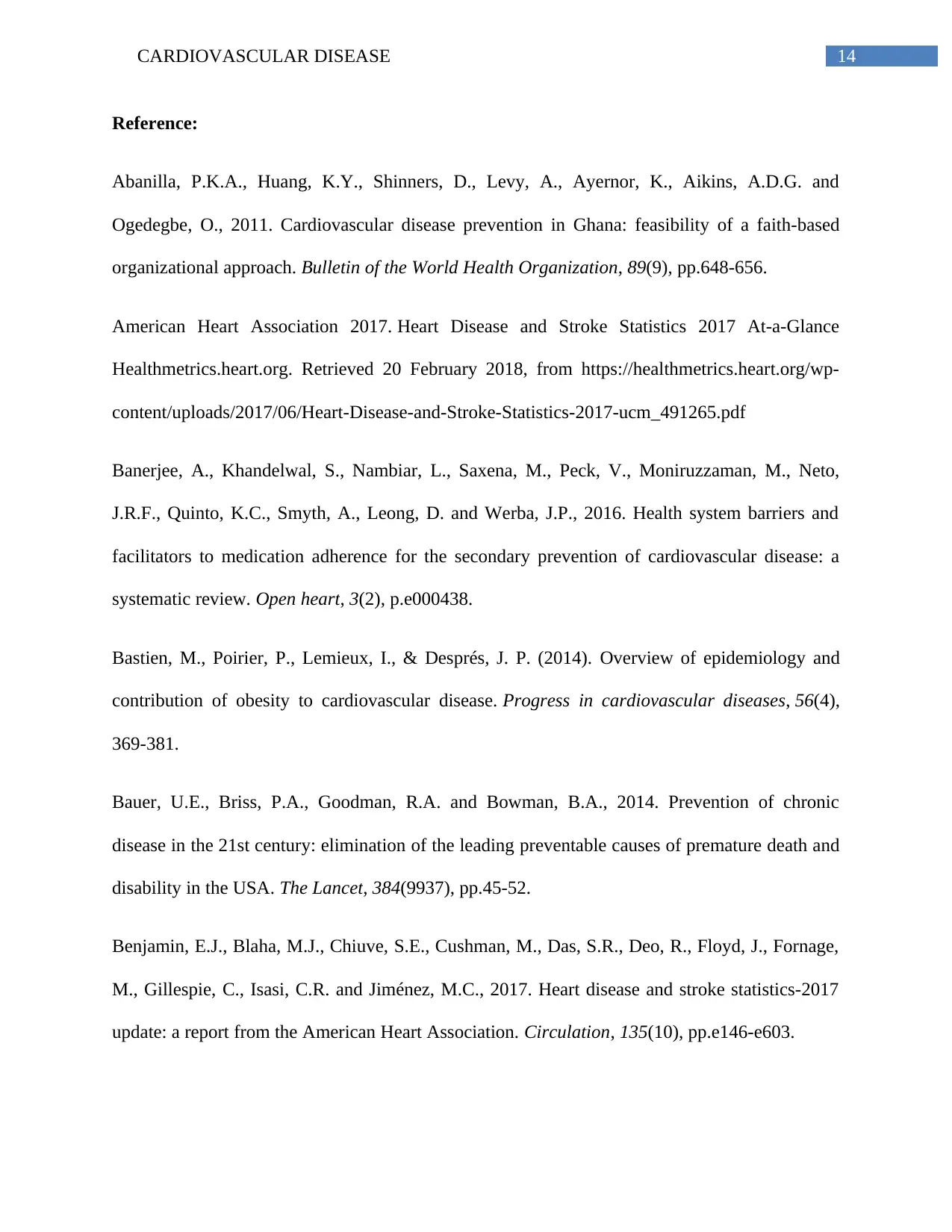
14CARDIOVASCULAR DISEASE
Reference:
Abanilla, P.K.A., Huang, K.Y., Shinners, D., Levy, A., Ayernor, K., Aikins, A.D.G. and
Ogedegbe, O., 2011. Cardiovascular disease prevention in Ghana: feasibility of a faith-based
organizational approach. Bulletin of the World Health Organization, 89(9), pp.648-656.
American Heart Association 2017. Heart Disease and Stroke Statistics 2017 At-a-Glance
Healthmetrics.heart.org. Retrieved 20 February 2018, from https://healthmetrics.heart.org/wp-
content/uploads/2017/06/Heart-Disease-and-Stroke-Statistics-2017-ucm_491265.pdf
Banerjee, A., Khandelwal, S., Nambiar, L., Saxena, M., Peck, V., Moniruzzaman, M., Neto,
J.R.F., Quinto, K.C., Smyth, A., Leong, D. and Werba, J.P., 2016. Health system barriers and
facilitators to medication adherence for the secondary prevention of cardiovascular disease: a
systematic review. Open heart, 3(2), p.e000438.
Bastien, M., Poirier, P., Lemieux, I., & Després, J. P. (2014). Overview of epidemiology and
contribution of obesity to cardiovascular disease. Progress in cardiovascular diseases, 56(4),
369-381.
Bauer, U.E., Briss, P.A., Goodman, R.A. and Bowman, B.A., 2014. Prevention of chronic
disease in the 21st century: elimination of the leading preventable causes of premature death and
disability in the USA. The Lancet, 384(9937), pp.45-52.
Benjamin, E.J., Blaha, M.J., Chiuve, S.E., Cushman, M., Das, S.R., Deo, R., Floyd, J., Fornage,
M., Gillespie, C., Isasi, C.R. and Jiménez, M.C., 2017. Heart disease and stroke statistics-2017
update: a report from the American Heart Association. Circulation, 135(10), pp.e146-e603.
Reference:
Abanilla, P.K.A., Huang, K.Y., Shinners, D., Levy, A., Ayernor, K., Aikins, A.D.G. and
Ogedegbe, O., 2011. Cardiovascular disease prevention in Ghana: feasibility of a faith-based
organizational approach. Bulletin of the World Health Organization, 89(9), pp.648-656.
American Heart Association 2017. Heart Disease and Stroke Statistics 2017 At-a-Glance
Healthmetrics.heart.org. Retrieved 20 February 2018, from https://healthmetrics.heart.org/wp-
content/uploads/2017/06/Heart-Disease-and-Stroke-Statistics-2017-ucm_491265.pdf
Banerjee, A., Khandelwal, S., Nambiar, L., Saxena, M., Peck, V., Moniruzzaman, M., Neto,
J.R.F., Quinto, K.C., Smyth, A., Leong, D. and Werba, J.P., 2016. Health system barriers and
facilitators to medication adherence for the secondary prevention of cardiovascular disease: a
systematic review. Open heart, 3(2), p.e000438.
Bastien, M., Poirier, P., Lemieux, I., & Després, J. P. (2014). Overview of epidemiology and
contribution of obesity to cardiovascular disease. Progress in cardiovascular diseases, 56(4),
369-381.
Bauer, U.E., Briss, P.A., Goodman, R.A. and Bowman, B.A., 2014. Prevention of chronic
disease in the 21st century: elimination of the leading preventable causes of premature death and
disability in the USA. The Lancet, 384(9937), pp.45-52.
Benjamin, E.J., Blaha, M.J., Chiuve, S.E., Cushman, M., Das, S.R., Deo, R., Floyd, J., Fornage,
M., Gillespie, C., Isasi, C.R. and Jiménez, M.C., 2017. Heart disease and stroke statistics-2017
update: a report from the American Heart Association. Circulation, 135(10), pp.e146-e603.
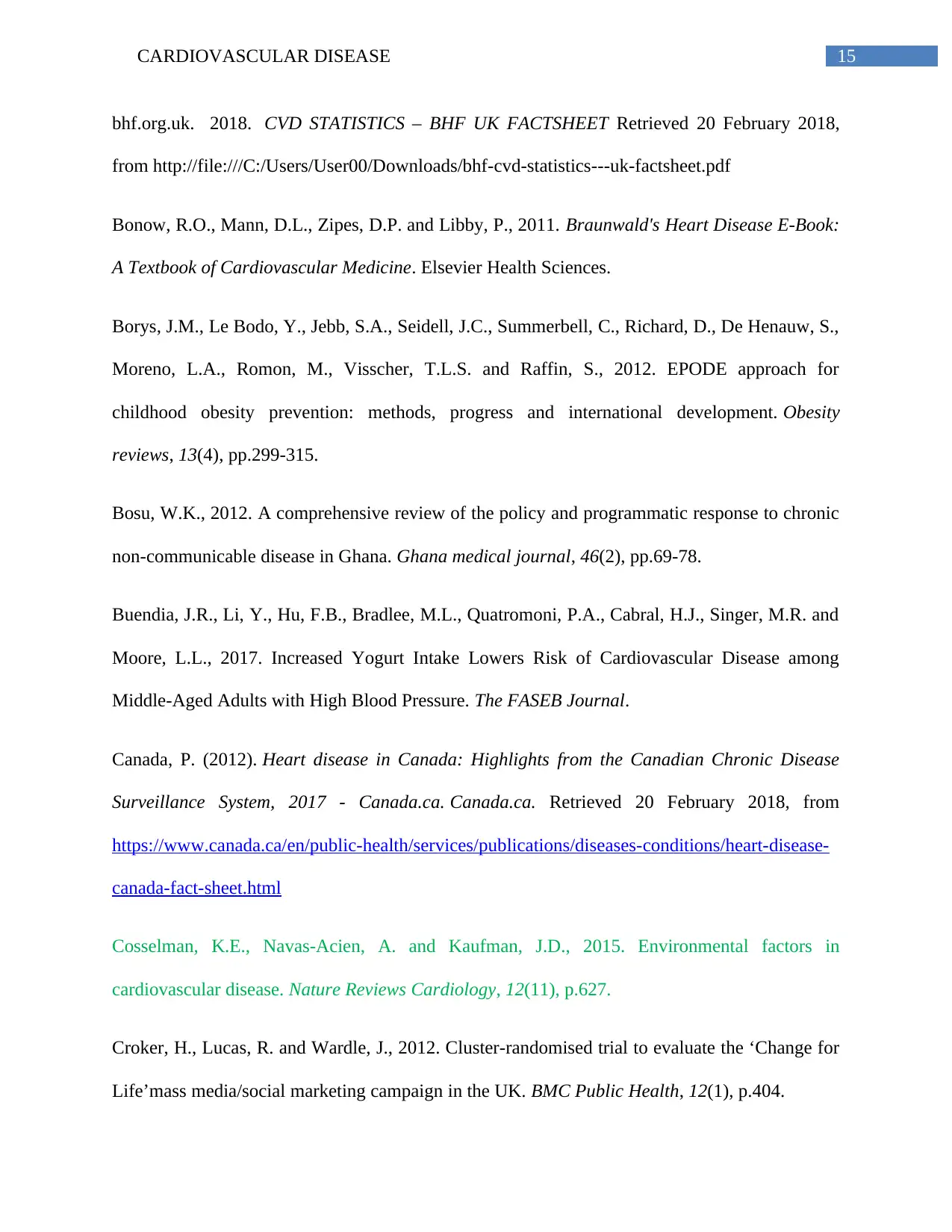
15CARDIOVASCULAR DISEASE
bhf.org.uk. 2018. CVD STATISTICS – BHF UK FACTSHEET Retrieved 20 February 2018,
from http://file:///C:/Users/User00/Downloads/bhf-cvd-statistics---uk-factsheet.pdf
Bonow, R.O., Mann, D.L., Zipes, D.P. and Libby, P., 2011. Braunwald's Heart Disease E-Book:
A Textbook of Cardiovascular Medicine. Elsevier Health Sciences.
Borys, J.M., Le Bodo, Y., Jebb, S.A., Seidell, J.C., Summerbell, C., Richard, D., De Henauw, S.,
Moreno, L.A., Romon, M., Visscher, T.L.S. and Raffin, S., 2012. EPODE approach for
childhood obesity prevention: methods, progress and international development. Obesity
reviews, 13(4), pp.299-315.
Bosu, W.K., 2012. A comprehensive review of the policy and programmatic response to chronic
non-communicable disease in Ghana. Ghana medical journal, 46(2), pp.69-78.
Buendia, J.R., Li, Y., Hu, F.B., Bradlee, M.L., Quatromoni, P.A., Cabral, H.J., Singer, M.R. and
Moore, L.L., 2017. Increased Yogurt Intake Lowers Risk of Cardiovascular Disease among
Middle-Aged Adults with High Blood Pressure. The FASEB Journal.
Canada, P. (2012). Heart disease in Canada: Highlights from the Canadian Chronic Disease
Surveillance System, 2017 - Canada.ca. Canada.ca. Retrieved 20 February 2018, from
https://www.canada.ca/en/public-health/services/publications/diseases-conditions/heart-disease-
canada-fact-sheet.html
Cosselman, K.E., Navas-Acien, A. and Kaufman, J.D., 2015. Environmental factors in
cardiovascular disease. Nature Reviews Cardiology, 12(11), p.627.
Croker, H., Lucas, R. and Wardle, J., 2012. Cluster-randomised trial to evaluate the ‘Change for
Life’mass media/social marketing campaign in the UK. BMC Public Health, 12(1), p.404.
bhf.org.uk. 2018. CVD STATISTICS – BHF UK FACTSHEET Retrieved 20 February 2018,
from http://file:///C:/Users/User00/Downloads/bhf-cvd-statistics---uk-factsheet.pdf
Bonow, R.O., Mann, D.L., Zipes, D.P. and Libby, P., 2011. Braunwald's Heart Disease E-Book:
A Textbook of Cardiovascular Medicine. Elsevier Health Sciences.
Borys, J.M., Le Bodo, Y., Jebb, S.A., Seidell, J.C., Summerbell, C., Richard, D., De Henauw, S.,
Moreno, L.A., Romon, M., Visscher, T.L.S. and Raffin, S., 2012. EPODE approach for
childhood obesity prevention: methods, progress and international development. Obesity
reviews, 13(4), pp.299-315.
Bosu, W.K., 2012. A comprehensive review of the policy and programmatic response to chronic
non-communicable disease in Ghana. Ghana medical journal, 46(2), pp.69-78.
Buendia, J.R., Li, Y., Hu, F.B., Bradlee, M.L., Quatromoni, P.A., Cabral, H.J., Singer, M.R. and
Moore, L.L., 2017. Increased Yogurt Intake Lowers Risk of Cardiovascular Disease among
Middle-Aged Adults with High Blood Pressure. The FASEB Journal.
Canada, P. (2012). Heart disease in Canada: Highlights from the Canadian Chronic Disease
Surveillance System, 2017 - Canada.ca. Canada.ca. Retrieved 20 February 2018, from
https://www.canada.ca/en/public-health/services/publications/diseases-conditions/heart-disease-
canada-fact-sheet.html
Cosselman, K.E., Navas-Acien, A. and Kaufman, J.D., 2015. Environmental factors in
cardiovascular disease. Nature Reviews Cardiology, 12(11), p.627.
Croker, H., Lucas, R. and Wardle, J., 2012. Cluster-randomised trial to evaluate the ‘Change for
Life’mass media/social marketing campaign in the UK. BMC Public Health, 12(1), p.404.
Secure Best Marks with AI Grader
Need help grading? Try our AI Grader for instant feedback on your assignments.

16CARDIOVASCULAR DISEASE
Department of Health 2013. Cardiovascular Disease Outcomes Strategy Improving outcomes for
people with or at risk of cardiovascular disease. Gov.uk. Retrieved 20 February 2018, from
https://www.gov.uk/government/uploads/system/uploads/attachment_data/file/214895/9387-
2900853-CVD-Outcomes_web1.pdf
Dibb, S., 2017. Changing Times for Social Marketing Segmentation. In Segmentation in Social
Marketing (pp. 41-59). Springer, Singapore.
Drummond, M.F., Sculpher, M.J., Claxton, K., Stoddart, G.L. and Torrance, G.W.,
2015. Methods for the economic evaluation of health care programmes. Oxford university press.
Fenenga, C.J., Nketiah-Amponsah, E., Ogink, A., Arhinful, D.K., Poortinga, W. and Hutter, I.,
2015. Social capital and active membership in the Ghana National Health Insurance Scheme-a
mixed method study. International journal for equity in health, 14(1), p.118.
Ferdinand, K.C., Patterson, K.P., Taylor, C., Fergus, I.V., Nasser, S.A. and Ferdinand, D.P.,
2012. Community‐Based Approaches to Prevention and Management of Hypertension and
Cardiovascular Disease. The Journal of Clinical Hypertension, 14(5), pp.336-343.
Gallo, L.C., Roesch, S.C., Fortmann, A.L., Carnethon, M.R., Penedo, F.J., Perreira, K.,
Birnbaum-Weitzman, O., Wassertheil-Smoller, S., Castañeda, S.F., Talavera, G.A. and Sotres-
Alvarez, D., 2014. Associations of chronic stress burden, perceived stress, and traumatic stress
with cardiovascular disease prevalence and risk factors in the HCHS/SOL Sociocultural
Ancillary Study. Psychosomatic medicine, 76(6), p.468.
Gillespie, D.O., Allen, K., Guzman-Castillo, M., Bandosz, P., Moreira, P., McGill, R., Anwar,
E., Lloyd-Williams, F., Bromley, H., Diggle, P.J. and Capewell, S., 2015. The health equity and
Department of Health 2013. Cardiovascular Disease Outcomes Strategy Improving outcomes for
people with or at risk of cardiovascular disease. Gov.uk. Retrieved 20 February 2018, from
https://www.gov.uk/government/uploads/system/uploads/attachment_data/file/214895/9387-
2900853-CVD-Outcomes_web1.pdf
Dibb, S., 2017. Changing Times for Social Marketing Segmentation. In Segmentation in Social
Marketing (pp. 41-59). Springer, Singapore.
Drummond, M.F., Sculpher, M.J., Claxton, K., Stoddart, G.L. and Torrance, G.W.,
2015. Methods for the economic evaluation of health care programmes. Oxford university press.
Fenenga, C.J., Nketiah-Amponsah, E., Ogink, A., Arhinful, D.K., Poortinga, W. and Hutter, I.,
2015. Social capital and active membership in the Ghana National Health Insurance Scheme-a
mixed method study. International journal for equity in health, 14(1), p.118.
Ferdinand, K.C., Patterson, K.P., Taylor, C., Fergus, I.V., Nasser, S.A. and Ferdinand, D.P.,
2012. Community‐Based Approaches to Prevention and Management of Hypertension and
Cardiovascular Disease. The Journal of Clinical Hypertension, 14(5), pp.336-343.
Gallo, L.C., Roesch, S.C., Fortmann, A.L., Carnethon, M.R., Penedo, F.J., Perreira, K.,
Birnbaum-Weitzman, O., Wassertheil-Smoller, S., Castañeda, S.F., Talavera, G.A. and Sotres-
Alvarez, D., 2014. Associations of chronic stress burden, perceived stress, and traumatic stress
with cardiovascular disease prevalence and risk factors in the HCHS/SOL Sociocultural
Ancillary Study. Psychosomatic medicine, 76(6), p.468.
Gillespie, D.O., Allen, K., Guzman-Castillo, M., Bandosz, P., Moreira, P., McGill, R., Anwar,
E., Lloyd-Williams, F., Bromley, H., Diggle, P.J. and Capewell, S., 2015. The health equity and

17CARDIOVASCULAR DISEASE
effectiveness of policy options to reduce dietary salt intake in England: policy forecast. PLoS
One, 10(7), p.e0127927.
Goldstein, L.B., Bushnell, C.D., Adams, R.J., Appel, L.J., Braun, L.T., Chaturvedi, S., Creager,
M.A., Culebras, A., Eckel, R.H., Hart, R.G. and Hinchey, J.A., 2010. Guidelines for the primary
prevention of stroke. A guideline for healthcare professionals from the American Heart
Association/American Stroke Association. Stroke.
Gov.uk. 2018. Action Plan for Cardiovascular Disease Prevention 2017-2018. Retrieved 21
February 2018, from https://www.gov.uk/government/uploads/system/uploads/attachment_data/
file/648190/cardiovascular_disease_prevention_action_plan_2017_to_2018.pdf
Grover, S.A., Kaouache, M., Rempel, P., Joseph, L., Dawes, M., Lau, D.C. and Lowensteyn, I.,
2015. Years of life lost and healthy life-years lost from diabetes and cardiovascular disease in
overweight and obese people: a modelling study. The lancet Diabetes & endocrinology, 3(2),
pp.114-122.
Health.go.ke. 2015. KENYA STEPwise SURVEY FOR NON COMMUNICABLE DISEASES
RISK FACTORS 2015 REPORT. Retrieved 20 February 2018, from http://www.health.go.ke/wp-
content/uploads/2016/04/Executive-summary-6-2.pdf
Hemming, K., Ryan, R., Gill, P., Westerby, P., Jolly, K. and Marshall, T., 2016. Targeted case
finding in the prevention of cardiovascular disease: a stepped wedge cluster randomised
controlled trial. Br J Gen Pract, pp.bjgpoct-2016.
Iccp-portal.org. 2012. National Policy for the Prevention and Control of Chronic Non-
Communicable Diseases in Ghana. Retrieved 21 February 2018, from http://www.iccp-
effectiveness of policy options to reduce dietary salt intake in England: policy forecast. PLoS
One, 10(7), p.e0127927.
Goldstein, L.B., Bushnell, C.D., Adams, R.J., Appel, L.J., Braun, L.T., Chaturvedi, S., Creager,
M.A., Culebras, A., Eckel, R.H., Hart, R.G. and Hinchey, J.A., 2010. Guidelines for the primary
prevention of stroke. A guideline for healthcare professionals from the American Heart
Association/American Stroke Association. Stroke.
Gov.uk. 2018. Action Plan for Cardiovascular Disease Prevention 2017-2018. Retrieved 21
February 2018, from https://www.gov.uk/government/uploads/system/uploads/attachment_data/
file/648190/cardiovascular_disease_prevention_action_plan_2017_to_2018.pdf
Grover, S.A., Kaouache, M., Rempel, P., Joseph, L., Dawes, M., Lau, D.C. and Lowensteyn, I.,
2015. Years of life lost and healthy life-years lost from diabetes and cardiovascular disease in
overweight and obese people: a modelling study. The lancet Diabetes & endocrinology, 3(2),
pp.114-122.
Health.go.ke. 2015. KENYA STEPwise SURVEY FOR NON COMMUNICABLE DISEASES
RISK FACTORS 2015 REPORT. Retrieved 20 February 2018, from http://www.health.go.ke/wp-
content/uploads/2016/04/Executive-summary-6-2.pdf
Hemming, K., Ryan, R., Gill, P., Westerby, P., Jolly, K. and Marshall, T., 2016. Targeted case
finding in the prevention of cardiovascular disease: a stepped wedge cluster randomised
controlled trial. Br J Gen Pract, pp.bjgpoct-2016.
Iccp-portal.org. 2012. National Policy for the Prevention and Control of Chronic Non-
Communicable Diseases in Ghana. Retrieved 21 February 2018, from http://www.iccp-
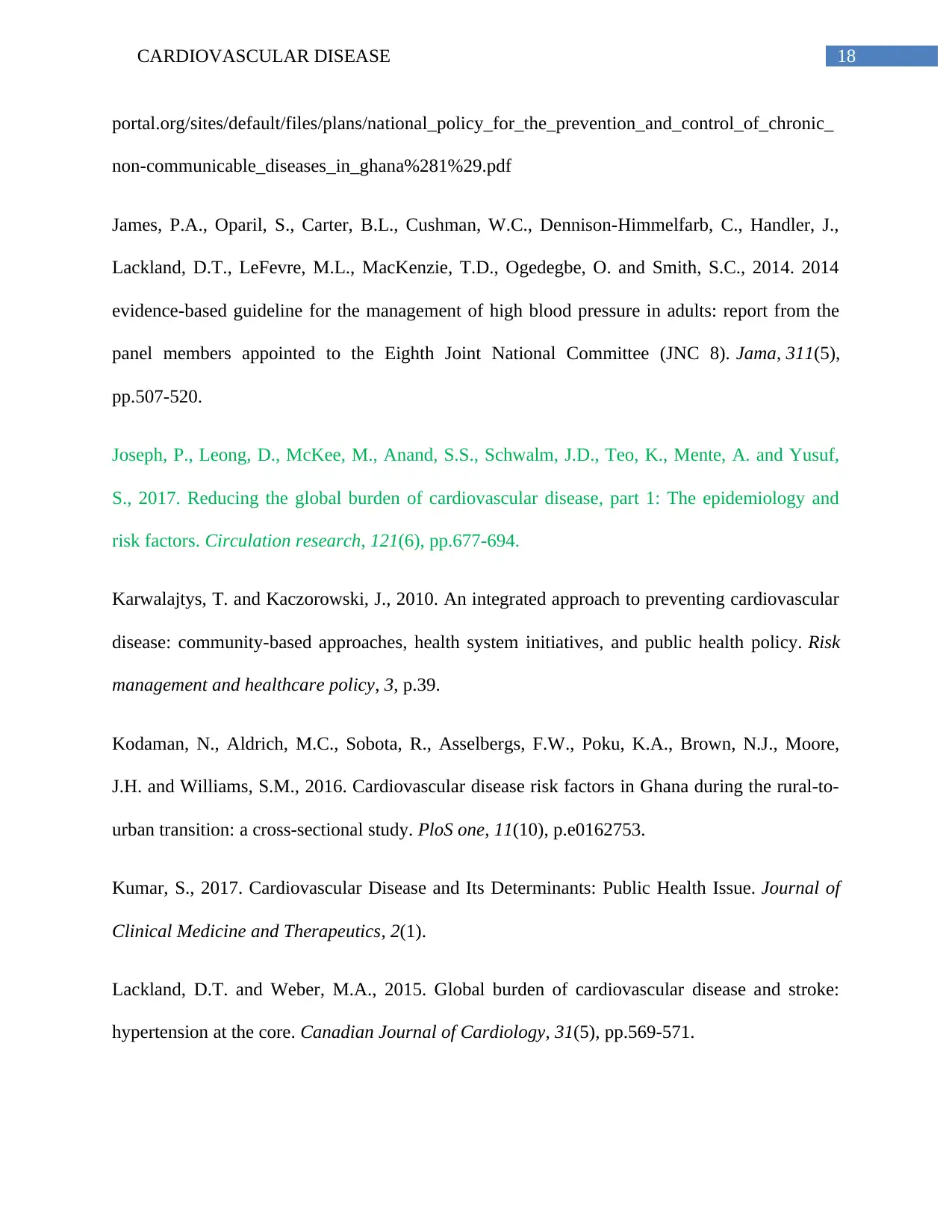
18CARDIOVASCULAR DISEASE
portal.org/sites/default/files/plans/national_policy_for_the_prevention_and_control_of_chronic_
non-communicable_diseases_in_ghana%281%29.pdf
James, P.A., Oparil, S., Carter, B.L., Cushman, W.C., Dennison-Himmelfarb, C., Handler, J.,
Lackland, D.T., LeFevre, M.L., MacKenzie, T.D., Ogedegbe, O. and Smith, S.C., 2014. 2014
evidence-based guideline for the management of high blood pressure in adults: report from the
panel members appointed to the Eighth Joint National Committee (JNC 8). Jama, 311(5),
pp.507-520.
Joseph, P., Leong, D., McKee, M., Anand, S.S., Schwalm, J.D., Teo, K., Mente, A. and Yusuf,
S., 2017. Reducing the global burden of cardiovascular disease, part 1: The epidemiology and
risk factors. Circulation research, 121(6), pp.677-694.
Karwalajtys, T. and Kaczorowski, J., 2010. An integrated approach to preventing cardiovascular
disease: community-based approaches, health system initiatives, and public health policy. Risk
management and healthcare policy, 3, p.39.
Kodaman, N., Aldrich, M.C., Sobota, R., Asselbergs, F.W., Poku, K.A., Brown, N.J., Moore,
J.H. and Williams, S.M., 2016. Cardiovascular disease risk factors in Ghana during the rural-to-
urban transition: a cross-sectional study. PloS one, 11(10), p.e0162753.
Kumar, S., 2017. Cardiovascular Disease and Its Determinants: Public Health Issue. Journal of
Clinical Medicine and Therapeutics, 2(1).
Lackland, D.T. and Weber, M.A., 2015. Global burden of cardiovascular disease and stroke:
hypertension at the core. Canadian Journal of Cardiology, 31(5), pp.569-571.
portal.org/sites/default/files/plans/national_policy_for_the_prevention_and_control_of_chronic_
non-communicable_diseases_in_ghana%281%29.pdf
James, P.A., Oparil, S., Carter, B.L., Cushman, W.C., Dennison-Himmelfarb, C., Handler, J.,
Lackland, D.T., LeFevre, M.L., MacKenzie, T.D., Ogedegbe, O. and Smith, S.C., 2014. 2014
evidence-based guideline for the management of high blood pressure in adults: report from the
panel members appointed to the Eighth Joint National Committee (JNC 8). Jama, 311(5),
pp.507-520.
Joseph, P., Leong, D., McKee, M., Anand, S.S., Schwalm, J.D., Teo, K., Mente, A. and Yusuf,
S., 2017. Reducing the global burden of cardiovascular disease, part 1: The epidemiology and
risk factors. Circulation research, 121(6), pp.677-694.
Karwalajtys, T. and Kaczorowski, J., 2010. An integrated approach to preventing cardiovascular
disease: community-based approaches, health system initiatives, and public health policy. Risk
management and healthcare policy, 3, p.39.
Kodaman, N., Aldrich, M.C., Sobota, R., Asselbergs, F.W., Poku, K.A., Brown, N.J., Moore,
J.H. and Williams, S.M., 2016. Cardiovascular disease risk factors in Ghana during the rural-to-
urban transition: a cross-sectional study. PloS one, 11(10), p.e0162753.
Kumar, S., 2017. Cardiovascular Disease and Its Determinants: Public Health Issue. Journal of
Clinical Medicine and Therapeutics, 2(1).
Lackland, D.T. and Weber, M.A., 2015. Global burden of cardiovascular disease and stroke:
hypertension at the core. Canadian Journal of Cardiology, 31(5), pp.569-571.
Paraphrase This Document
Need a fresh take? Get an instant paraphrase of this document with our AI Paraphraser
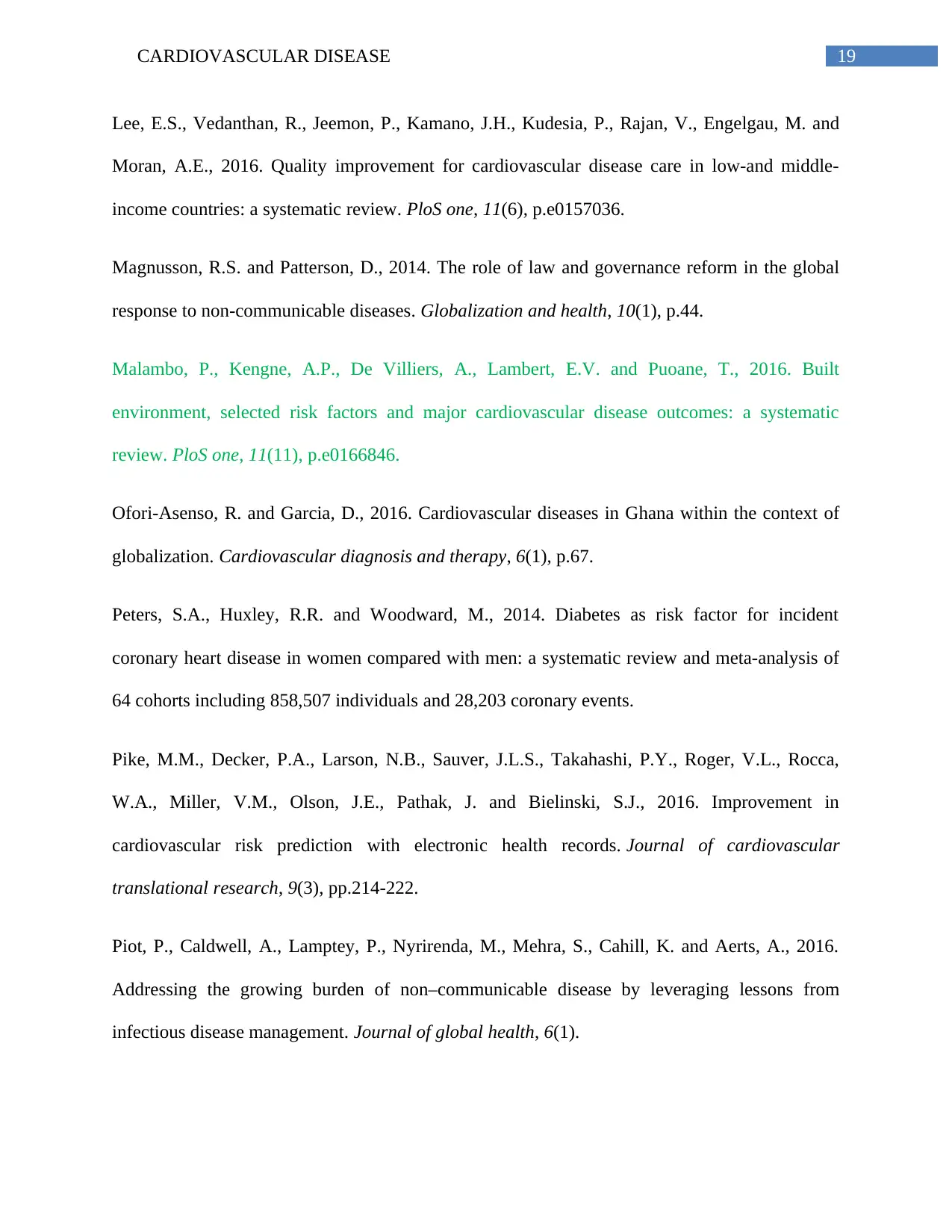
19CARDIOVASCULAR DISEASE
Lee, E.S., Vedanthan, R., Jeemon, P., Kamano, J.H., Kudesia, P., Rajan, V., Engelgau, M. and
Moran, A.E., 2016. Quality improvement for cardiovascular disease care in low-and middle-
income countries: a systematic review. PloS one, 11(6), p.e0157036.
Magnusson, R.S. and Patterson, D., 2014. The role of law and governance reform in the global
response to non-communicable diseases. Globalization and health, 10(1), p.44.
Malambo, P., Kengne, A.P., De Villiers, A., Lambert, E.V. and Puoane, T., 2016. Built
environment, selected risk factors and major cardiovascular disease outcomes: a systematic
review. PloS one, 11(11), p.e0166846.
Ofori-Asenso, R. and Garcia, D., 2016. Cardiovascular diseases in Ghana within the context of
globalization. Cardiovascular diagnosis and therapy, 6(1), p.67.
Peters, S.A., Huxley, R.R. and Woodward, M., 2014. Diabetes as risk factor for incident
coronary heart disease in women compared with men: a systematic review and meta-analysis of
64 cohorts including 858,507 individuals and 28,203 coronary events.
Pike, M.M., Decker, P.A., Larson, N.B., Sauver, J.L.S., Takahashi, P.Y., Roger, V.L., Rocca,
W.A., Miller, V.M., Olson, J.E., Pathak, J. and Bielinski, S.J., 2016. Improvement in
cardiovascular risk prediction with electronic health records. Journal of cardiovascular
translational research, 9(3), pp.214-222.
Piot, P., Caldwell, A., Lamptey, P., Nyrirenda, M., Mehra, S., Cahill, K. and Aerts, A., 2016.
Addressing the growing burden of non–communicable disease by leveraging lessons from
infectious disease management. Journal of global health, 6(1).
Lee, E.S., Vedanthan, R., Jeemon, P., Kamano, J.H., Kudesia, P., Rajan, V., Engelgau, M. and
Moran, A.E., 2016. Quality improvement for cardiovascular disease care in low-and middle-
income countries: a systematic review. PloS one, 11(6), p.e0157036.
Magnusson, R.S. and Patterson, D., 2014. The role of law and governance reform in the global
response to non-communicable diseases. Globalization and health, 10(1), p.44.
Malambo, P., Kengne, A.P., De Villiers, A., Lambert, E.V. and Puoane, T., 2016. Built
environment, selected risk factors and major cardiovascular disease outcomes: a systematic
review. PloS one, 11(11), p.e0166846.
Ofori-Asenso, R. and Garcia, D., 2016. Cardiovascular diseases in Ghana within the context of
globalization. Cardiovascular diagnosis and therapy, 6(1), p.67.
Peters, S.A., Huxley, R.R. and Woodward, M., 2014. Diabetes as risk factor for incident
coronary heart disease in women compared with men: a systematic review and meta-analysis of
64 cohorts including 858,507 individuals and 28,203 coronary events.
Pike, M.M., Decker, P.A., Larson, N.B., Sauver, J.L.S., Takahashi, P.Y., Roger, V.L., Rocca,
W.A., Miller, V.M., Olson, J.E., Pathak, J. and Bielinski, S.J., 2016. Improvement in
cardiovascular risk prediction with electronic health records. Journal of cardiovascular
translational research, 9(3), pp.214-222.
Piot, P., Caldwell, A., Lamptey, P., Nyrirenda, M., Mehra, S., Cahill, K. and Aerts, A., 2016.
Addressing the growing burden of non–communicable disease by leveraging lessons from
infectious disease management. Journal of global health, 6(1).

20CARDIOVASCULAR DISEASE
Robson, J., Dostal, I., Sheikh, A., Eldridge, S., Madurasinghe, V., Griffiths, C., Coupland, C. and
Hippisley-Cox, J., 2016. The NHS Health Check in England: an evaluation of the first 4
years. BMJ open, 6(1), p.e008840.
Thomas, C. and Power, C., 2009. Working characteristics and cardiovascular disease: are
associations confounded by early life risk factors?. Journal of Epidemiology & Community
Health, 63(Suppl 2), pp.3-3.
World Health Organization 2017. Non communicable diseases. Retrieved 20 February 2018,
from http://www.who.int/mediacentre/factsheets/fs355/en/
World Health Organization. 2017. Cardiovascular diseases (CVDs). Retrieved 20 February
2018, from http://www.who.int/mediacentre/factsheets/fs317/en/
Robson, J., Dostal, I., Sheikh, A., Eldridge, S., Madurasinghe, V., Griffiths, C., Coupland, C. and
Hippisley-Cox, J., 2016. The NHS Health Check in England: an evaluation of the first 4
years. BMJ open, 6(1), p.e008840.
Thomas, C. and Power, C., 2009. Working characteristics and cardiovascular disease: are
associations confounded by early life risk factors?. Journal of Epidemiology & Community
Health, 63(Suppl 2), pp.3-3.
World Health Organization 2017. Non communicable diseases. Retrieved 20 February 2018,
from http://www.who.int/mediacentre/factsheets/fs355/en/
World Health Organization. 2017. Cardiovascular diseases (CVDs). Retrieved 20 February
2018, from http://www.who.int/mediacentre/factsheets/fs317/en/
1 out of 21
Related Documents
Your All-in-One AI-Powered Toolkit for Academic Success.
+13062052269
info@desklib.com
Available 24*7 on WhatsApp / Email
![[object Object]](/_next/static/media/star-bottom.7253800d.svg)
Unlock your academic potential
© 2024 | Zucol Services PVT LTD | All rights reserved.




